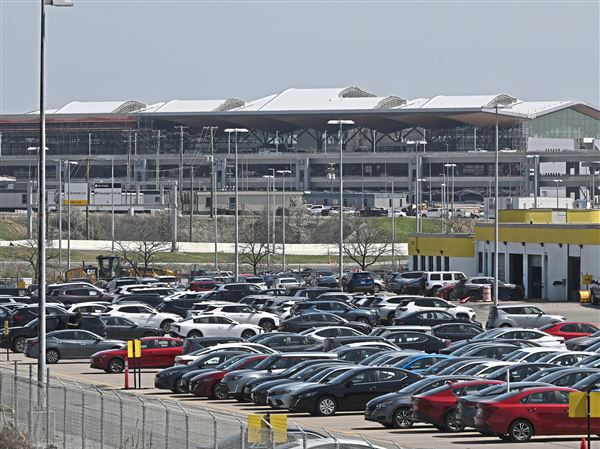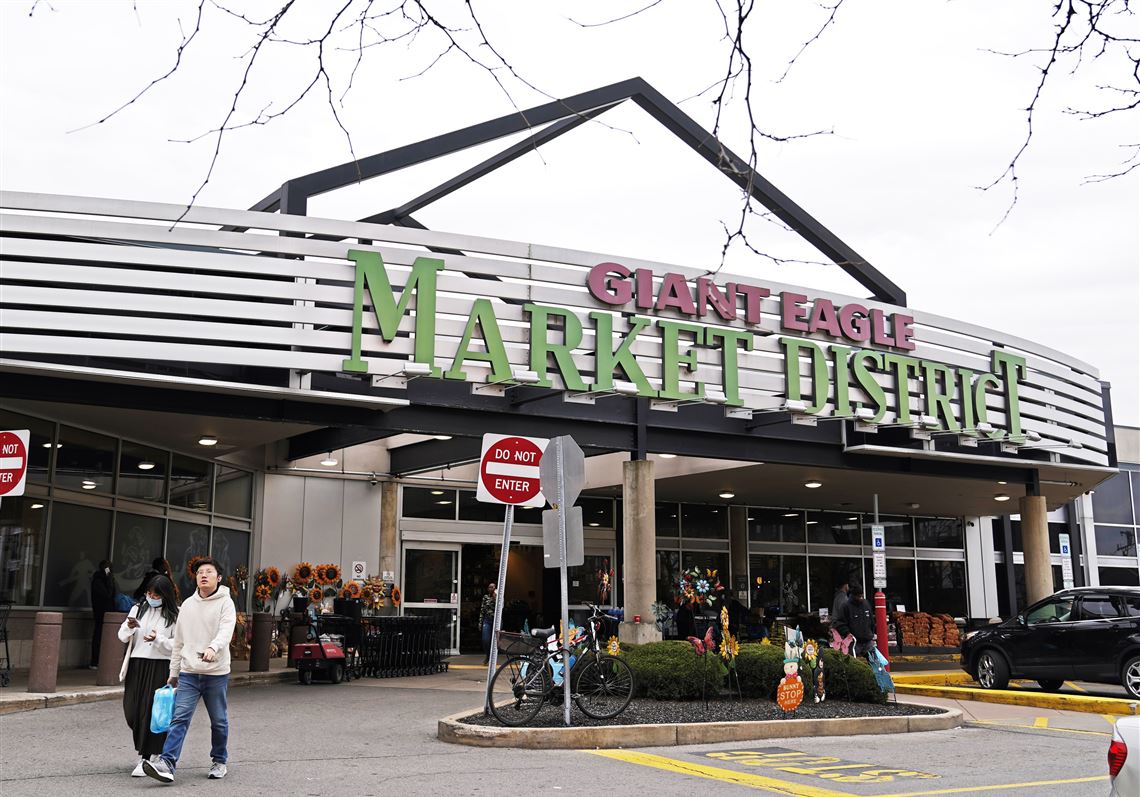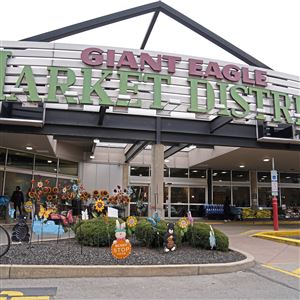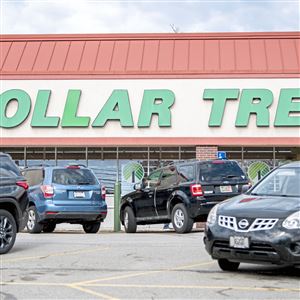For the first time in decades, Giant Eagle is no longer the grocery market leader in the Pittsburgh region, knocked off its perch by the world’s largest retailer, Walmart Inc.
The Arkansas-based giant, which has 25 stores in Pittsburgh and its surrounding counties, has edged ahead of the O’Hara-based grocer to capture more than 25% of the market share here.
But not just here. Regional newspapers have been writing this story for years.
Walmart gets the biggest share of American grocery dollars, with Cincinnati-based Kroger Co. a distant second, according to research compiled by Scott Moses, managing director of New York-based Solomon Partners.
“Walmart is the largest grocer in the U.S. by a wide margin,” he said.
Over the past year, Walmart and Giant Eagle switched places at the top of the chart in the Greater Pittsburgh area — a nearly $7 billion grocery market. Giant Eagle’s market share fell to 21% in 2022, compared with 25% in 2021, according to data from Chain Store Guide.
The company recently replaced its CEO, Laura Shapira Karet, with longtime Giant Eagle employee Bill Artman, the first non-family leader of a nearly century-old company founded and held closely by five families.
With 2022 sales of $11.1 billion, Giant Eagle has more than 470 locations across Pennsylvania, Ohio, West Virginia, Maryland and Indiana.
In the Pittsburgh region, it has 67 company-owned supermarkets and a half dozen independently-owned franchise stores.
Other grocery retailers making strides in Pittsburgh last year included Target, which gained 3% market share, and BJ Wholesale Club, with a 2% gain. Sam’s Club, which is owned by Walmart, and Costco rank third and fourth in this market.
Again, Pittsburgh is following the national trend of supersizing.
“Costco is now the number 3 grocer in the U.S.,” Mr. Moses said. “Same groceries, just bigger packs.”
The average Costco makes seven times as much in grocery sales as the average supermarket, he said.
“America’s strongest supermarket chains — particularly family-owned grocers like Giant Eagle — lead with competitive advantages such as local products, better service and fun community events,” Mr. Moses said.
The key is to build a connection with customers and make them want to be part of the family of Giant Eagle, he said.
The Walmart revolution
It was sometime in the late 1990s that Walmart began its advance on the grocery market around Pittsburgh. It had about half a dozen supercenters in the area by 2004 with plans to double that in short order.
“When Walmart first came on the horizon, I thought it was just sort of a distant mirage, not going to bother us much,” Jerry Chait, a Giant Eagle company director, recalled in the 2008 book about the history of Giant Eagle called Taking Flight.
“That immediately became wrong. They wanted to bother everybody,” he wrote.
Chuck Porter, another director, said in the book that when a Walmart supercenter moved into a Giant Eagle’s territory, the supermarket would lose sales initially but eventually it would adjust and reverse course.
“What ends up happening is we grow and Walmart grows,” Mr. Porter wrote.
That’s not to say Giant Eagle is eager to see Walmart grow. In 2016, in an attempt to foil Walmart’s plan of building a supercenter in McCandless, Giant Eagle bought two tracts of land crucial to the proposed development. Walmart eventually pulled the plug on its plan.
In “Taking Flight,” Mr. Porter touted what differentiated Giant Eagle from Walmart: in-store child care for shopping parents, meat, seafood — “none of these are available at Walmart,” he said.
But 15 years later, those differences aren’t as stark. Giant Eagle closed all of its Eagle’s Nest child care centers, citing lower interest from customers who’d grown more comfortable with online ordering and curbside pickup. Walmart now offers meat and seafood and has deli counters in some stores.
In fact, groceries now make up about 60% of Walmart’s sales. And during the past few quarters, the majority of new grocery sales have come from higher-income customers, CFO John David said at an investor conference last week.
During two days of investor presentations last week, Walmart executives said this isn’t the first time that higher-income customers popped in for a bit of a value boost during a downturn. In previous iterations, those customers were simply travelers who left when times improved.
“But this time — and I'm really confident — it can be different because we offer so many more solutions in terms of flexibility with omni store solutions,” said John Furner, Walmart’s president and CEO.
The Walmart apparatus is trained on getting them to stay, he said, by expanding home delivery options to include groceries along with other merchandise, growing the number of private label products available, and advertising sales on multiple platforms.
Giant Eagle says it’s doing the same. In a statement from its interim CEO, the company highlighted its myPerks platform that links shoppers’ grocery and gas purchases to accumulate discounts. It also gave a nod to the value shopper.
“We are constantly exploring opportunities to provide additional value to our guests, including reducing and locking prices on important items across the store,” Mr. Artman said.
What shoppers want
A few years before the pandemic began, the National Grocers Association polled shoppers about their loyalty to independent grocers like Giant Eagle, finding it “strong” but with an asterisk. If prices were to rise by 5% at their local grocery story, some 19% of shoppers said they would leave. Faced with a 10% price increase, 58% said they would look for other options.
The past few years, and 2022 in particular, put those numbers to the test. Last year, food grocery prices increased by 11.4%, according to the U.S. Department of Agriculture, after several years of single digit increases.
And while the change has been in the works for years, the traditional supermarket is no longer the primary destination for grocery shoppers.
According to shopping trend data collected by the Food Marketing Institute, only 40% of consumers said the supermarket is their first choice for groceries in 2022, down from 52% in 2014.
But that doesn’t mean it’s not part of the mix. The average household clocks nearly three grocery trips a week and most shop multiple stores, mixing in online orders with boots on the ground.
They are also spending more money on groceries across the board. The Food Marketing Institute calculated that the average household shelled out $148 on groceries weekly, a large jump from $114 in 2019, the last full year before the pandemic began.
Walmart is certainly getting a bigger chunk of that basket in the Pittsburgh region, and beyond.
“Over 90% of Americans live within 10 miles of a Walmart,” Mr. Moses wrote. It is now “ubiquitous,” he said.
Anya Litvak: alitvak@post-gazette.com
First Published: April 9, 2023, 9:30 a.m.
Updated: April 10, 2023, 10:58 a.m.
























